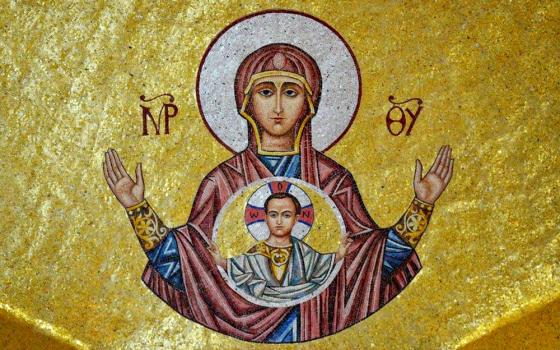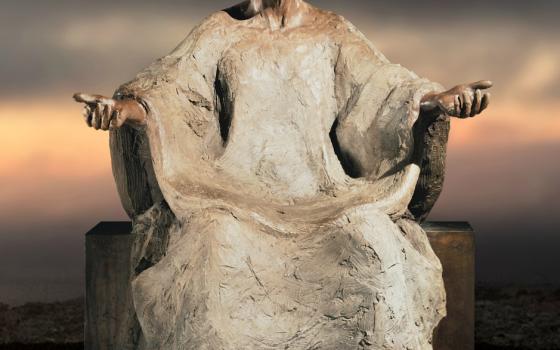Sacred art, in its stillness, holds an energy that often opens our minds and hearts to a new way of seeing the truths of our faith. I invite you on a virtual pilgrimage with me.
Threatened by persecution, Christians painted silent witnesses to their faith on the walls of the catacombs. The second-century Catacomb of Priscilla in Rome preserves the oldest image of Mary holding Jesus close to her breast. (See Figure 1.) Some claim the figure beside them depicts the prophet Balaam announcing "a star shall rise out of Jacob, and a scepter from Israel" (Numbers 24:17).
Another image (seen here) found in Rome's third-century Catacomb Maggiore, shows a woman, hands raised in prayer, her child seated on her lap. Are Mary's hands raised in prayer a silent witness that the Child on her lap is God's Eternal Son? Such images of Mary and Jesus are said to have influenced icons and frescoes that appeared from the fifth century on. That Mary was proclaimed "Theotokos," "Mother of God," at the Council of Ephesus in 431 C.E. probably did also.
The oldest Byzantine icon of Mary with Jesus on her lap appeared in St. Catherine's Monastery, Sinai, Egypt, in the sixth century. Sts. Theodore and George stand on either side of them. Behind, two angels point to a hand described as a symbol of God the Father. William Allen suggests that the icon portrays "zones of holiness" — the cosmos, earth and real people, heavenly angels and the hand of God. "The viewer who stands before the scene makes this cosmos complete, from 'our earth' to heaven."
An interesting observation. For the first time, I sense a connection being made silently between Mary, the Incarnation and the Cosmic Christ and the entire cosmos. Jesus portrayed with an adult face, his infant feet now visible, likely has some connection also. Hopefully, the meaning will unfold on the journey.
Seeking an answer, I happened on the ninth-century mosaic of Hagia Sophia (Holy Wisdom) in the cathedral in Constantinople dedicated to the Wisdom of God, the Logos (Word of God), second person of the Trinity (Figure 2).
Here also, Mary sits on a throne, holding Jesus on her lap. At the mosaic's unveiling, the patriarch said, "Christ came to us in the flesh and was borne in the arms of his mother. This is seen and confirmed and proclaimed in pictures."
The icon Our Lady of the Sign, which originated in 12th-century Russia, furthers the patriarch's thought (Figure 3).
The energy emanating from the eyes of Our Lady of the Sign and her Son centered on his mother's body in the icon draws me to contemplate her Son in another piece of art — a mandorla, symbolizing the coming together of heaven and earth, the human and divine in Mary's womb.
Our Lady of the Sign connects us to the Incarnation. Jesus is the eternal Son, Word of God from his conception. His adult face and infant feet (sometimes visible in icons) are said to be an artistic way of communicating that Jesus is both divine and human. God, the Creator, has chosen to enter into the unfolding of human history by becoming human in Jesus.
A contemporary icon (Figure 4) by one of our sister-artists — depicting Our Lady of the Sign — portrays this well. Mary bearing and giving birth to Jesus, the Creator of the world, is interrelated with the cosmos and creation. The three interlocking circles represent the dynamic presence and energy of the Trinity. In Christ, all is sacred.
As we move on, it seems important to consider what Scripture reveals about Jesus. St. Paul announces that Jesus is the Cosmic Christ, for he is image of the invisible God, in whom all things in heaven and on earth were created and hold together (Colossians 1:15-17; John 1:1-5). Jesus the Christ will carry out God's plan to unite all things in heaven and on earth in the fullness of time (Ephesians 1:10).
The Book of Revelation identifies Jesus, the Word of God, the Christ, as "the Alpha and Omega, the first and the last, the beginning and the end" (Revelation 22:12-13). Teilhard de Chardin underlines in The Divine Milieu that the Omega is the final point in the process where the law of universal love will have reached its climax in Jesus, the Christ. Its meaning is grounded in Jesus, to whom Mary gave birth — his life, mission, death on the cross and resurrection.
Mary's creative yes at the Annunciation has been described as a cosmic yes. By conceiving and giving birth to the Creator of the world, Mary embraced the universe in her person. A point supported by Meister Eckhart, who wrote, "God creates the entire universe fully and totally in the innermost depths of every soul now."
For St. Maximus the Confessor (580-662 C.E.), the Annunciation models what God wants to achieve in us by the power of the Spirit. Like Mary, I am called to inner freedom that allows this Mystery to unfold in me. An awesome challenge. Is there a hidden message in the images contemplated that give some indication as to how this Mystery unfolds in my daily life?
To my surprise, I felt an urge to consider the invocation Mary, Seat of Wisdom, in the Litany of Loreto, which I hadn't prayed in years. By exploring its meaning, I sensed that Mary would show the way.
Images showing Mary, her Child seated on her lap or centered on her body (Our Lady of the Sign) reveal that Jesus, the eternal Wisdom of God, first nestled in her womb, is visible now for all to see. This resulted in Mary being named Seat of Wisdom by St. Augustine in the fourth century (Figure 5).
I so easily forget that, like Mary, I am God's dwelling place in whom God's Spirit dwells (1 Corinthians 3:16), a seat of Wisdom — a gift from my baptism, strengthened in confirmation. Yet, like Mary, I am called to listen to God's call in my life, to turn all things over in my heart while praying for wisdom to know how to choose wisely.
This 20th-century sculpture of Mary, Seat of Wisdom, a mature, older woman, gathers the threads together for me (Figure 6). The smile on her face, her arms extended with open hands and feet planted firmly on the dais — echo for me her ongoing openness to God's call as life unfolded in her time and circumstances. A beautiful reminder that I am God's mission on this earth, even as age advances.
Her very posture mirrors also the importance of my turning again and again toward my neighbor in love as violence and exploitation of people and our planet increases at home and abroad. For me, reaching out in love must have compassion, mercy, forgiveness, justice at its core.
In spite of my limitations, reaching out in love will enable me to walk daily in Mary's footsteps and, in faith, allow the Mystery of the Incarnation, the Cosmic Christ and the cosmos to work in and through me.
[Marie Azzarello, a member of the Congregation of Notre Dame of Montreal, is an adult educator in the Montreal Archdiocese. She is the author of two books; concern for peace, justice, and environmental issues continue to find expression in her ministry of spirituality and writing.]






